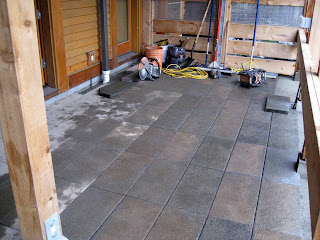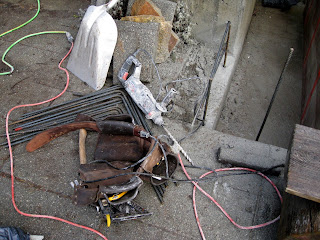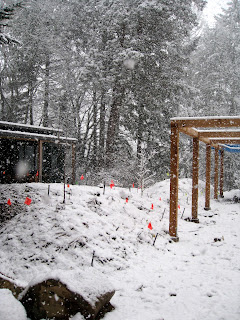I wrote a couple of posts about the shoes I wear going to and from the studio and inside the studio
here and
here.
With the past snowy winter I had to add another pair of footwear - waterproof rubber boots with New Zealand wool liners. These are also my gardening boots. It is usual to wear longer boots when gardening in forest areas to protect the legs from deer ticks.
Recently I added a pair of Skellerup 'Red Band' flip flops/jandles/thongs to my studio shoe collection. I purchased them in New Zealand where they and 'Red Band' gumboots are de rigeur when in the countryside. Now the paths have been leveled and covered with gravel it is no longer hazardous to walk to and from my studio and these are perfect for slipping on and off during the warm months.
Finally the lumber Josh ordered came in and he was able to finish the cedar fence with the top beam.
In theory that meant there would be no more construction activity in the area between the fence and the studio. Finally I could get going on making the new garden bed.
The soil is in rough shape. It has been driven over, walked over, turned into mud over the rainy season and dust in the dry season. It is thoroughly compacted, full of rocks and stones and has little organic matter - so I need to provide the conditions for the soil organisms to make new soil.
First I dug it over taking out all of the rocks in the first few inches. Then I covered it with a thick layer of all the paper and cardboard I had collected from the house and from dumpster diving.
This paper is the 'Party Time' signal for the earthworms, woodlice/slaters and hundreds of other bugs to start partying/eating.
Normally this layer has to be soaked with water using the hose but the outside water has not been turned on for the season yet so I made this first layer the day before rain was forecast. As predicted, it got thoroughly drenched.
I measured out the path and started construction of the rock edge using rock blasted from the pergola area.
Next layer - coffee grounds courtesy of our local coffee houses/cafes. As I have posted about before - the coffee is the green and the filters and coffee cups are the brown in the compost mix.
Then the muscle moved in dumping wheelbarrow loads of a 'cooked' spent hops mash from a local brewery and the shreddings from a nearby landscaper - a potent mix.
Tah dah - new garden bed. While the soil organisms do their work transforming the layers into soil I have the pleasurable task of planning the plantings.
Taylor placed the rocks along the bottom of the fence so the bambi deer could not squeeze under it and get inside the backyard. The mother deer on the other side do crazy things when this happens.
I think of this as a bonus garden bed. I didn't have it in my original concept design and I didn't know how big it would be until the fence was in place and the path was marked out. Not only is it a big bed it is also a pleasing shape.
























































